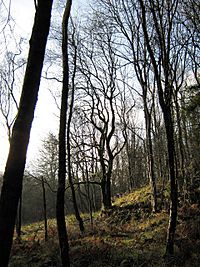Lady Park Wood National Nature Reserve facts for kids
Lady Park Wood National Nature Reserve is a special forest that covers about 45 hectares (110 acres). It sits right on the border between Gloucestershire in England and Monmouthshire in Wales. Most of this amazing wood is actually in Wales, but it's looked after by an agreement with Natural England, a group that protects nature in England.
This beautiful wood is found in the Wye Valley, which is a designated Area of Outstanding Natural Beauty. This means it's a really special place with stunning landscapes. Lady Park Wood is also part of the Upper Wye Gorge Site of Special Scientific Interest (SSSI) and the River Wye Special Area of Conservation (SAC). These titles show how important the area is for its unique plants, animals, and habitats.
The Forestry Commission owns the site. You can explore parts of it using public footpaths. However, if you want to visit areas that aren't public, you'll need special permission. Lady Park Wood has been a research site for a long time because it's left mostly untouched. It's a key place for studying and protecting woodlands. Fun fact: the Welsh part of Lady Park Wood is the easternmost point in all of Wales!
Contents
Exploring Lady Park Wood: Location and Habitat
Lady Park Wood is thought to be one of the most important places in the United Kingdom for protecting woodlands. It's located on the southern side of a deep gorge carved out by the winding River Wye. You can find it about halfway between the towns of Monmouth and Ross-on-Wye.
This wood is part of a long stretch of forest that runs along the lower Wye Valley and connects to the famous Forest of Dean. The closest village to the reserve is Symonds Yat.
Why Lady Park Wood is Important for Research
Back in 1938, the Forestry Commission started letting ecologists (scientists who study how living things interact with their environment) set up research areas. Lady Park Wood became the only one of these reserves in the UK, established in 1944. Since then, scientists have regularly studied the wood.
In 1945, the wood had old trees that had been cut back in a method called coppicing in 1870, and then thinned out in the early 1900s. After that, the trees were allowed to grow naturally without human interference. Scientists like George Peterken found that as trees grew, the number of trees actually went down. This happened because of more shade and deer eating young plants. Over time, big events like Dutch elm disease in the 1970s and a heavy snowfall in 1983 had a huge impact on the forest.
Researchers learned that there isn't just one "natural" mix of trees. Instead, the forest changes over time, sometimes having more beech trees and sometimes more ash and lime trees. This depends on natural events and disturbances. In recent years, non-native animals like fallow deer and grey squirrels have become very common. They eat young trees, which affects how the forest grows back.
The Easternmost Point of Wales
It's interesting to know that the part of Lady Park Wood that is in Wales is the easternmost point of the entire country. This means it's further east than many English towns, including Hereford, Leominster, and Shrewsbury.
Flora: Plants and Trees of Lady Park Wood
Lady Park Wood is home to many different types of trees. You'll find lots of beech trees, oak trees, ash, and two kinds of lime trees: small-leaved and large-leaved.
Other trees growing here include birch, field maple, aspen, yew, holly, whitebeam, and alder.
Understorey and Ground Flora
Below the main trees, the "understorey" is mostly made up of hazel bushes. You can also spot dogwood and hawthorn, which are common plants in this area.
On the forest floor, you'll see plants like dog's mercury and bramble. Other special plants found here include wild madder, toothwort, lily-of-the-valley, herb paris, and the beautiful bird's-nest orchid.
Fauna: Animals of Lady Park Wood
Lady Park Wood is a great place for birds! It has a rich bird community, including all three types of native woodpeckers found in the UK. You might also hear the calls of the tawny owl. Other birds that live here are the redstart, wood warbler, pied flycatcher, and treecreeper.
Bat Populations and Conservation
The Forest of Dean and the Wye Valley are well-known for their large populations of bats. There are several Sites of Special Scientific Interest (SSSIs) in both England and Wales that are set up to protect these bats. These areas provide safe places for bats to breed and hibernate, and the large forests offer plenty of food.
Scientists have recorded significant numbers of rarer bat species in Lady Park Wood, such as the lesser horseshoe bat and the greater horseshoe bat. Because of their importance, the Wye Valley and Forest of Dean Bat Sites are specially protected as a Special Area of Conservation.


